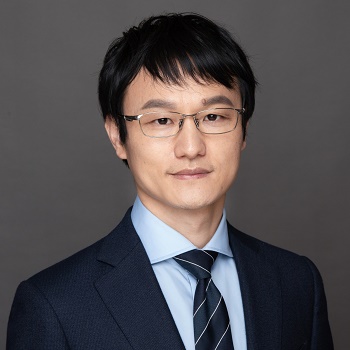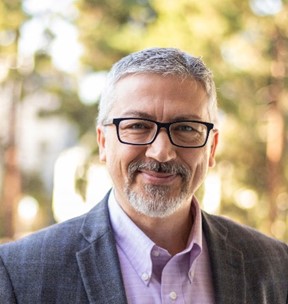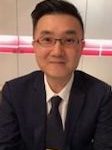Distinguished Lecturers 2022
The IEEE NTC is pleased to announce the appointments of Distinguished Lecturers for 2022.
Talks by NTC Distinguished Lecturers can be requested by: IEEE student branches; NTC or member Society Chapters; NTC and member Society Conferences; conferences of other IEEE Societies not members of the NTC for major plenary/keynote (based on availability of funding). Please contact the presenter directly to arrange for a presentation.
| DL Name |
Topic(s) |
| Antonio Di Bartolomeo | 1. Electrical transport measurements in 2D materials 2. Nanotransistors 3. 2D Materials: fabrication, properties and applications |
| Weida Hu | 1. Nanoscale infrared photodetectors manipulated by localized fields |
| Kin Fong Lei | 1. Analyses of Molecular Expression of Cancer Cells Cultured in Stacking Nanofiber Substrate 2. Impedimetric Monitoring of Cancer Cell Responses in Three-dimension Culture Environment |
| Elena A. Rozhkova* | 1. Merging Nanotechnology & Synthetic Biology toward Directed Evolution of Energy Materials 2. Magnetic Nanostructures for Future Medicine: from Cell Actuation to Ultrasensitive Detection 3. Nano for BRAIN technologies |
| Aida Todri-Sanial | 1. Novel devices and circuits design methods energy efficient neuromorphic computing with oscillatory neural networks |
| Massimiliano Di Ventra | 1. Quantum transport in nanoscale systems 2. MemComputing: Fundamentals and Applications 3. Next-generation sequencing with nanochannels 4. Industrial research from an academic point of view |
| Yang Xu | 1. Graphene/Silicon Heterojunctions for Integrated Nanotechnology |
| Ken-Tye Yong | 1. Nanocarbons for Biology and Medicine: Sensing, Imaging, and Drug Delivery |
| Yong Zhu | 1. Nanomaterial-Enabled Soft Electronics 2. MEMS for Characterizing Mechanical and Coupled Properties of Nanomaterials |
| * Re-appointment for second year. |
|
 Antonio Di Bartolomeo
Antonio Di Bartolomeo
Physics Department “E. R. Caianiello”, University of Salerno, Italy
E-Mail: adibartolomeo@unisa.it
Distinguished Lecturer Talk Title(s):
1. Electrical transport measurements in 2D materials
2. Nanotransistors
3. 2D Materials: fabrication, properties and applications
Abstract:
Two-dimensional materials hold great promise for future nanoelectronics. Their atomic thickness enables highly scaled field-effect transistors with reduced short-channel effects and relatively high carrier mobility that are essential for high-performance, low-voltage device operations. The electrical transport properties of 2D materials are mainly investigated using back-gated field-effect devices, for which conventional electrical characterization methods can produce unreliable results. The formation of low-resistance contacts and the control of process-induced defects or interface states are among the main challenges to solve for the study of intrinsic electrical transport of 2D materials. The accurate characterization of parameters such as conductivity, carrier density, mobility, contact resistance, Schottky barriers, interface trap density, etc. is very important for the progress in the field. In this lecture, I’ll highlight the main issues related to the electrical characterization of 2D materials and I’ll review the electrical measurements techniques that are commonly applied to 2D-based field-effect transistors, such as current–voltage (I–V) characterization, 2- and 4-point probe measurements, Hall-effect measurements, transmission line method and capacitance–voltage (C-V) measurements. I will include scanning probe microscopy techniques to address the correlation between electrical device parameters and the nanoscale properties of 2D materials.
Bio:
Antonio DI BARTOLOMEO is a full professor of Experimental Condensed Matter Physics and president of the Physics Education Committee at the University of Salerno, Italy, where he teaches semiconductor device physics and nanoelectronics.
His present research interests include optical and electrical properties of nanostructured materials such as carbon nanotubes, graphene, and 2D materials; van der Waals heterostructures, Schottky junctions, field-effect transistors, non-volatile memories, solar cells, photodetectors, field emission devices, supercapacitors, and fuel cells.
He received the Ph.D. in Physics in 1997 from the University of Salerno where he held the position of researcher in Experimental Physics for several years before his appointment as a professor. His scientific career started at CERN (CH) with the collaboration with experiments on neutrino oscillations and heavy-ion collisions. He spent several years in the industry as a semiconductor device engineer (ST Microelectronics, Infineon Technologies, and Intel Corporation) and was a guest scientist at IHP-Microelectronics (Germany) and Georgetown University (Washington, DC).
He has delivered about 100 presentations in international conferences and has authored over 150 publications in peer-reviewed journals, two physics textbooks, and two patents. He is serving as the editor-in-chief of IOP Nano Express, the deputy editor-in-chief of IET Micro & Nano Letters, the section editor-in-chief of MDPI Nanomaterials and is an Editorial Board member of several journals such as IOP Nanotechnology, IOP Nano Futures, MDPI Materials and MDPI Sensors.
 Weida Hu
Weida Hu
Shanghai Institute of Technology Physics, Chinese Academy of Sciences
E-Mail: wdhu@mail.sitp.ac.cn
Distinguished Lecturer Talk Title:
Nanoscale infrared photodetectors manipulated by localized fields
Abstract:
Photodetectors and image sensors, especially in the infrared wavelength regime, are core components of various optical instruments for medical imaging, remote sensing, night vision, surveillance, etc. The current commercial infrared photodetectors are mostly based on bulk materials including In1-xGaxAs, InSb, Hg1-xCdxTe, etc. Despite continued advancement, technological factors limit the widespread usage of such photodetectors, especially, the need for cooling, and the high costs associated with the processing of III-V and II-VI semiconductors. Nanoscale materials, including 0D quantum dots, 1D nanowires, and 2D layered materials, with strong light-matter coupling coefficient, quantum confinement, and ease of heterostructure construction, are emerged as alternative material platforms for high-performance photodetection technologies at room temperature. Nevertheless, as an infrared photodetector, the signal-to-noise ratio could be very low without the suppression of dark current. Meanwhile, the performance of 1D and 2D photodetectors is strongly affected by surface states resulting in the restricted electron-hole separation efficiency and low speed, and intrinsic ultrathin absorption thickness of low-dimensional materials suffers from low quantum efficiency. Understanding the physical mechanisms of localized fields in nanoscale infrared photodetectors is of great importance to achieving high-performance infrared photodetection technology.
Dr. Weida Hu and his research group have demonstrated various localized fields and their corresponding photodetection mechanisms, including interlayer built-in field, ferroelectric field, photo-induced field, vertical heterojunction field, p-n junction built-in field, etc. With the assistance of a strongly induced localized field, infrared detectors based on 1D nanowires and 2D layered materials achieved high-performance infrared photodetection, which may lead to a disruptive revolution in prospective nanoscale photodetection technologies. Dr. Weida Hu’s research opens a new avenue for the controllable fabrication of nanoscale infrared photodetectors manipulated by localized fields, which is a prominent challenge in the field of functional nanodevices.
Bio:
Weida Hu is currently a full professor working on nanoscale infrared photodetectors and their AI vision chips at Shanghai Institute of Technology Physics, Chinese Academy of Sciences. He has authored and co-authored more than 200 SCI papers including Science, Nat. Nanotechnol, Nat. Electron. Nat. Commun., and more than 10 IEEE-related journals such as EDL, TED with the total citations of 13000 and h-index of 61. He received the National Science Fund for Distinguished Young Scholars in 2017, China Youth Science and Technology Award in 2019, and National Science Fund for Excellent Young Scholars in 2013. He is selected as the IEEE Senior Member and Royal Society-Newton Advanced Fellowship in 2017. He is also serving as the Committee Member of IEEE Nanotechnology Council (TC-03), the Associate Editor of Infrared Physics & Technology, the Executive Editor of Optical and Quantum Electronics, the Program Committee of SPIE DCS Defense and Security-Infrared Technology and Applications (USA), and the Program Committee of the International Conference on Numerical Simulation of Optoelectronic Devices.
 Dr. Kin Fong Lei
Dr. Kin Fong Lei
Chang Gung University (CGU), Taiwan
Email: kflei@mail.cgu.edu.tw
Distinguished Lecturer Talk Title(s):
1. Analyses of Molecular Expression of Cancer Cells Cultured in Stacking Nanofiber Substrate
2. Impedimetric Monitoring of Cancer Cell Responses in Three-dimension Culture Environment
Abstract:
In this talk, nanofiber substrate was used for culturing biological cells in three-dimensional space. Viability and molecular expression of cells could be directly analyzed. Cells were cultured in nanofiber substrate and expressed cell properties in three-dimensional environment. By stacking the nanofiber substrates, three-dimensional solid tumor tissue could be simulated to study the internal hypoxic environment of solid tumor. Cellular response in each layer could be analyzed by de-assembling the nanofiber substrates after the culture course. The result showed that internal hypoxic environment was successfully re-produced in the stacking nanofiber construct. The cells in the inner layer expressed high levels of HIF1- and VEGFA. Hence, proliferation and migration of endothelial cells were shown to be induced by the cells located in the internal hypoxic environment. Moreover, the stacking nanofiber construct was transplanted to a nude mice for the study of hypoxic response and angiogenesis. The crosstalk between internal and external parts of solid tumor could be analyzed by sectioning each layer of the stacking nanofiber construct. This approach provides a favorable analytical method for the discovery of the interaction between cancer cells, hypoxia, and peripheral angiogenesis.
Bio:
Dr. Kin Fong Lei is a Professor in Biomedical Engineering and Dean for International Affairs at Chang Gung University (CGU), Taiwan. Prior to joining CGU, he was a Lecturer at The Hong Kong Polytechnic University, Hong Kong (2007-2010). He received PhD degree from The Chinese University of Hong Kong, Hong Kong in 2005. Dr. Lei has made significant original contributions to research in micro/nanofabrication, bio-microfluidics, and molecular biology. He has published over 100 peer-reviewed articles and was invited to contribute in 8 book/book chapters. Dr. Lei is Fellow of the Royal Society of Chemistry (RSC), Fellow of the Institute of Physics (IOP), and Senior Member of Institute of Electrical and Electronics Engineers (IEEE). He serves as the Chair of IEEE-NTC Technical Committee on Nanorobotics and Nanomanufacturing (2021-2022). He is the General Chair of IEEE-NANOMED 2021 and the Program Chair of IEEE-NEMS 2022. He is the Associate Editor for IEEE Access and IEEE Transactions on NanoBiosciences.
 Dr. Elena A. Rozhkova
Dr. Elena A. Rozhkova
Argonne National Laboratory, IL, USA
Email: rozhkova@anl.gov
Distinguished Lecturer Talk Title(s):
1. Merging Nanotechnology & Synthetic Biology toward Directed Evolution of Energy Materials
2. Magnetic Nanostructures for Future Medicine: from Cell Actuation to Ultrasensitive Detection
3. Nano for BRAIN technologies
Abstract:
The biological use of solar energy for synthesis of fuels from water and carbon dioxide inspires researchers and engineers in their efforts to replace exhaustible energy sources with renewable technologies. Environmentally friendly schemes of photocatalytic energy conversion, known as artificial photosynthesis, along with inorganic materials, also use biological structures, such as molecules, enzymes, machineries of whole microorganisms capable of light-harvesting, water splitting, carbon dioxide and proton reduction. In this talk, I will make an argument that merging nanotechnology, biotechnology and synthetic biology approaches allows for systemic manipulation at the nanoparticle-bio interface toward directed evolution of energy materials, novel environmentally friendly catalytic, “artificial life” systems and, ultimately, to circular economy. For example, purple membranes isolated from Halobacteria cells or, more recently, obtained via cell-free synthetic biology approaches, were integrated with TiO2 nanoparticles to produce hydrogen or reduce carbon dioxide. These new functions are not typical of the host microorganism. On the other hand, interplay between plasmon resonance of photonic (Au, Ag) nanoparticles and natural mechanisms of the same light-sensitive membranes in engineered hollow hybrids, or “artificial cell”, resulted in ATP photosynthesis.
Bio:
Dr. Rozhkova earned her Ph.D. in Chemistry at the Moscow State Institute for Fine Chemical Technology. She then worked in Japan as a postdoctoral fellow of Japan Society for Promotion of Science at Tohoku University. After moving to the US in 2003, she became a research staff member at the Chemistry Department of Princeton University, and later she moved to Chicago. Since joining the Center for Nanoscale Materials at Argonne National Laboratory in 2007, Elena has focused on a general theme of nano-bio interfaces, one of the most exciting interdisciplinary research fields of our time. Success in this area can lead to the solution of emerging problems of civilization, for example, to provide alternative sustainable energy, to advance medical technologies in the diagnosis and treatment of incurable diseases.
 Aida Todri-Sanial
Aida Todri-Sanial
Director of Research for the French National Council of Scientific Research (CNRS) attached to Laboratoire d’Informatique de Robotique et de Microélectronique de Montpellier (LIRMM)
Email: aida.todri@lirmm.fr
Distinguished Lecturer Talk Title:
Novel devices and circuits design methods energy efficient neuromorphic computing with oscillatory neural networks
Abstract:
Current classical computers are playing a critical role in advanced research such as in biology, climate analysis, economics, genomics, finance, etc. In many aspects, computing fuels the advances of our modern society. Yet, recent developments in artificial intelligence (AI) and machine learning will require even more powerful computing systems such as exascale computations per second due to an ever-increasing amount of data. But classical computing systems are hindered by the von-Neumann communication bottleneck, the physical separation between processor and memory. This offers the opportunity to explore a novel computing paradigm where the brain can serve as a computational model of how to deal with large amounts of (often fuzzy) information while being extremely dense, error-resilient and power efficient.
A novel and alternative neuromorphic computing paradigm based on oscillating neural networks (ONN) will be presented in this talk. Energy efficient relaxation oscillators based on phase-change material for oscillating neurons and tunable memristors for synapses are the building blocks of ONN architecture. Inspired by neural oscillations or brain waves, the information is encoded in the phase of coupled oscillators in ONN. The talk will cover aspects from materials, devices, circuits to ONN architecture design and hardware implementation and demonstration on AI tasks. This work is conducted in the framework of the EU H2020 NEURONN project, www.neuronn.eu.
Bio:
Aida Todri-Sanial received the B.S. degree in electrical engineering from Bradley University, IL in 2001, M.S. degree in electrical engineering from Long Beach State University, CA, in 2003 and a Ph.D. degree in electrical and computer engineering from the University of California, Santa Barbara, in 2009.
Her research interests focus on nanometer-scale issues in high-performance VLSI design with emphasis on energy efficiency, power, thermal, signal integrity, and reliability issues as well as on circuits and systems for emerging technologies and nanomaterials. Currently, her research is focused on exploring 1D/2D nanomaterials for nanoelectronics devices and novel computing paradigms such as neuromorphic computing and quantum computing.
She is currently a Director of Research for the French National Council of Scientific Research (CNRS) attached to Laboratoire d’Informatique de Robotique et de Microélectronique de Montpellier (LIRMM). Previously, she was an R&D Engineer for Fermi National Accelerator Laboratory, IL. She has also held summer and visiting research positions at Mentor Graphics, Cadence Design Systems, STMicroelectronics and IBM TJ Watson Research Center. From 2016 to 2017, Dr. Todri-Sanial was a Visiting Fellow at Wolfson College and Cambridge Graphene Center at the University of Cambridge, UK, working with Professor Andrea C. Ferrari.
 Massimiliano Di Ventra
Massimiliano Di Ventra
Department of Physics, University of California, San Diego
E-Mail: diventra@physics.ucsd.edu
Distinguished Lecturer Talk Title(s):
1. Quantum transport in nanoscale systems
2. MemComputing: Fundamentals and Applications
3. Next-generation sequencing with nanochannels
4. Industrial research from an academic point of view
Abstract:
MemComputing is a novel physics-based approach to computation that employs time nonlocality (memory) to both process and store information on the same physical location [1]. Its digital version is designed to solve combinatorial optimization problems. A practical realization of digital memcomputing machines (DMMs) can be accomplished via circuits of non-linear dynamical systems with memory engineered so that periodic orbits and chaos can be avoided. A given logic problem is first mapped into this type of dynamical system whose point attractors represent the solutions of the original problem. A DMM then finds the solution via a succession of elementary avalanches (instantons) whose role is to eliminate configurations of logical inconsistency (‘‘logical defects’’) from the circuit. I will discuss the physics behind MemComputing and show many examples of its applicability to various combinatorial optimization and Machine Learning problems demonstrating its advantages over traditional approaches and even quantum computing. Work supported by DARPA, DOE, NSF, CMRR,
and MemComputing, Inc.
[1] M. Di Ventra, MemComputing: Fundamentals and Applications (Oxford University Press, 2022).
Bio:
Massimiliano Di Ventra (Fellow, IEEE) obtained his undergraduate degree in Physics summa cum laude from the University of Trieste (Italy) in 1991 and did his PhD studies at the Swiss Federal Institute of Technology in Lausanne in 1993-1997. He is now professor of Physics at the University of California, San Diego. Di Ventra’s research interests are in condensed-matter theory and unconventional computing. He has been invited to deliver more than 300 talks worldwide on these topics. He has published more than 200 papers in refereed journals, and has 6 granted patents (2 international). He co-edited the textbook Introduction to Nanoscale Science and Technology (Springer, 2004) for undergraduate students, he is single author of the graduate-level textbook Electrical Transport in Nanoscale Systems (Cambridge University Press, 2008), the trade book The Scientific Method: Reflections from a Practitioner (Oxford University Press, 2018), and the monograph MemComputing: Fundamentals and Applications (Oxford University Press, 2022). He is a fellow of the IEEE, the American Physical Society, the Institute of Physics, and a foreign member of Academia Europaea. In 2018 he was named Highly Cited Researcher by Clarivate Analytics and he is the recipient of the 2020 Feynman Prize for theory in Nanotechnology. He is the co-founder of the startup MemComputing, Inc.
 Yang Xu
Yang Xu
School of Micro-Nano Electronics, Zhejiang University, Hangzhou, China
E-Mail: yangxu-isee@zju.edu.cn
Distinguished Lecturer Talk Title:
Graphene/Silicon Heterojunctions for Integrated Nanotechnology
Abstract:
Two-dimensional (2D) materials and their heterostructures represent a rapidly expanding class of materials, offering exciting features in exponentially growing areas of physics, and engineering. Low-power consumption, high operating speeds, and efficient energy conversion are the primary requirements for the next-generation electronic and optoelectronic devices, where 2D materials made their mark as the potential materials to resolve the limitations of silicon electronics. Developing device schemes by integrating graphene and 3D (bulk) materials enables us to continue the benefits of matured Si-based technology, while exploiting the novel features of low-dimensional materials. The DL lecture aims to provide a comprehensive understanding of the role of 2D-3D hybrid systems in emerging applications with functionalities superior to those of individual materials. This lecture also discusses how the intrinsic charge generation and transport features of 2D heterostructures can be integrated with Si technology to overcome the existing technological limitations and develop unique electronic and optoelectronic devices. The challenges and opportunities regarding the back-end-of-line and front-end-of-line integration of graphene with Si CMOS technologies will be discussed. Recent developments of graphene/Si heterojunction devices will also be presented. These devices, combining the benefits of graphene and Si, demonstrate their potential applications for post-Moore’s nanotechnology.
Bio:
Yang Xu received his B.S degree in ECE from Tsinghua University and Ph.D. degree in ECE from the University of Illinois Urbana-Champaign (UIUC), USA. He is now a full professor and Assistant Dean at the School of Micro-Nano Electronics, Zhejiang University, China. He is also a Fellow of Churchill College at the University of Cambridge, UK, and a visiting professor at the University of California Los Angles (UCLA). He has published more than 120 papers including Nature Nanotechnology, Nature Electronics, Nature Photonics, Chemical Reviews, Advanced Materials, Chemical Society Reviews, Nature Communications, Nano Letters, ACS Nano, and IEDM. He is an IEEE Senior Member of the Electron Devices Society. He holds over 30 granted patents and gives more than 50 talks in IEDM, MRS, APS and ICPS conferences. He also served as the TPC and committee members of IEEE, AIP, and IOP conferences. His current research interests include emerging low-dimensional smart sensors and photodetectors for internet-of-things and flexible electronics.
 Yong Zhu
Yong Zhu
Andrew A. Adams Distinguished Professor
North Carolina State University (NCSU)
Email: yzhu7@ncsu.edu
Distinguished Lecturer Talk Title(s):
1. Nanomaterial-Enabled Soft Electronics
2. MEMS for Characterizing Mechanical and Coupled Properties of Nanomaterials
Abstract:
Highly sensitive wearable sensors that can be conformably attached to human skin or integrated with textiles to monitor the physiological parameters of human body or the surrounding environment have garnered tremendous interest. Owing to the large surface area and outstanding material properties, nanomaterials are promising building blocks for wearable sensors. In this lecture I will start with a brief overview of the recent advances in the nanomaterial-enabled soft electronics (e.g., flexible, stretchable, and wearable sensors and soft robotics). Integration of multiple sensors for multimodal sensing and integration with other components into wearable systems will be summarized. Then I will present the array of wearable sensors developed in my group using silver nanowire (AgNW) composites including strain/pressure sensors, hydration sensors, temperature sensors, antennas and etc. AgNW composites offer outstanding combination of high conductivity and high stretchability. I will highlight a critical issue for developing AgNW-based stretchable devices – scalable nanomanufacturing. Electronic waste has become a pressing issue that poses a threat to health and environment. Here I will propose a recycling approach to address the issue using AgNWs as an example. I will conclude my talk with some recent work extending from wearable sensors for human health to wearable plant sensors and soft robotics.
Bio:
Prof. Yong Zhu is the Andrew A. Adams Distinguished Professor in the Department of Mechanical and Aerospace Engineering, with affiliated appointments in the Departments of Materials Science and Engineering and Biomedical Engineering, at North Carolina State University (NCSU). His group conducts research at the intersection of solid mechanics and micro/nano-technology, including nanomechanics, interfacial mechanics, micro/nano-electromechanical systems, and nanomaterial-enabled stretchable electronics.
 Ken-Tye Yong
Ken-Tye Yong
School of Biomedical Engineering, University of Sydney
Email: ken.yong@sydney.edu.au
Distinguished Lecturer Talk Title:
Nanocarbons for Biology and Medicine: Sensing, Imaging, and Drug Delivery
Abstract:
Nanocarbons with different dimensions (e.g., 0D fullerenes and carbon nanodots, 1D carbon nanotubes and graphene nanoribbons, 2D graphene and graphene oxides, and 3D nanodiamonds) have attracted enormous interest in numerous applications due to their unique properties [1]. Among them, theranostics (i.e. therapeutics and diagnostics) is one of the most intensely studied applications, as these nanocarbon materials serve as excellent biosensors, versatile drug/gene carriers for specific in vivo targets, effective photothermal nanoagents for cancer therapy, and promising fluorescent nanolabels for cell and tissue imaging. We first introduce the different carbon allotropes usable for theranostic applications, their physical and chemical properties, and their respective preparation and surface functionalization approaches. The protocols for both in vitro and in vivo theranostic applications are then described, followed by toxicity and biodegradability implications. The design considerations will outline the key unifying set of foundational first principles for investigating and realizing effective, biocompatible, and nontoxic nanocarbon materials-based models for cancer theranostics applications. Finally, the challenges and novel theranostic protocols for hard-to-treat cancers and other diseases will be summarized. This talk will present a guideline on the selection strategy of nanocarbon materials according
Bio:
Ken-Tye Yong is a Professor in the School of Biomedical Engineering and he also serves as the Associate Dean for External Engagement in the Faculty of Engineering at University of Sydney.
Ken-Tye earned his PhD in Chemical and Biological Engineering from State University of New York at Buffalo, USA. During his postdoctoral training at the Institute of Lasers, Photonics and Biophotonics at SUNY Buffalo, he worked extensively on synthesis and applications of nanomaterials. Prior to be an academic staff at Nanyang Technological University, he was a Samuel Stroum AACR research fellow, studying nanomedicine field where he engineered multimodal nanoprobes for pancreatic cancer detection and targeted gene and drug delivery therapy. Ken-Tye Yong was previously the Provost’s Chair in Electrical and Electronic Engineering, the Director of the Centre of Bio-Devices and Signal Analysis, and Program Director of Nanoelectronics Centre of Excellence at the Nanyang Technological University (NTU).
Ken-Tye is the recipient of a few internationally recognized prizes and awards such as 2017 Beilby Medal and Prize for his research work in using quantum dots and metal nanoparticles for nanomedicine, 2018 Rosenhain Medal and Prize for his pioneering work in applying TENG devices, 2D materials, and AIE nanoparticles for biophotonics, and 2018 Distinguished Lecturer Award from the IEEE Photonics Society. The first Beilby Medal and Rosenhain Medal awards were made in 1930 and 1951, respectively. The Beilby Medal and Prize is awarded annually to a scientist or engineer for work that has exceptional practical significance in chemical engineering, applied materials science, energy efficiency or a related field. The Rosenhain Medal and Prize is presented in recognition of distinguished achievement in any branch of materials science, with preference given to nominees in their early career. Ken-Tye is the first person to receive Beilby Medal Prize from an Asian University and the second Asian scientist to receive Rosenhain Medal.
